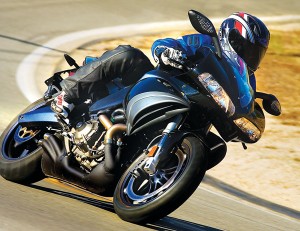
I like to root for the underdog. There’s something about watching a team beat the odds that makes me feel all warm and fuzzy inside. In some ways, Buell is considered an underdog in the sportbike arena. While the Japanese consistently amaze with technological advances, and the Italians deliver aesthetic crowd pleasers, Erik Buell has been quietly chipping away at the small (albeit loyal) part of the sportbike market that roots for Team USA. Buell’s steadfast “outside the box” approach to motorcycles is a breath of fresh air in a market that, some might say, is saturated in cookie-cutter machines. Its fuel-in-frame design, if nothing else, is unique and innovative. Its perimeter-mounted front brake is lightweight and effective, and its long-time use of underslung exhausts is an exercise in mass centralization that some other manufacturers recently began copying.
But Buell’s Harley Sportster-inspired engine, which has been the mainstay of its bikes for years, has simply been no match for the competition. Surely there were a few riders who cried, “I’d buy a Buell if only it had a different engine.” Well Erik Buell heard your pleas and this is his reply: the 2008 Buell 1125R.The product you see before you is almost two decades in the making. Buell had visions of a liquid-cooled model bearing his name as far back as 1989, but for various reasons the project never got off the ground. The Harley-Davidson V-Rod project was originally supposed to be the platform for Buell’s liquid-cooled future. However, as the project progressed, Buell’s influence on the engine diminished, ending in a V-Rod engine that was physically too large and too heavy for what Erik Buell had in mind.
Still determined, Buell then got permission to seek help from other sources. Not wanting to team with Porsche again (who helped with the V-Rod project), Buell struck a partnership with Rotax–which doesn’t come as too much of a surprise, considering it builds engines for Aprilia and BMW.
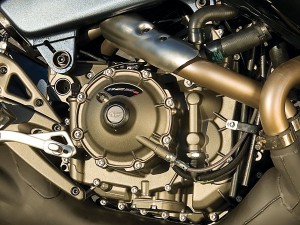
That engine, which is built to Buell specifications, is a 1,125cc, 72-degree liquid-cooled V-twin. Why the odd 1,125cc displacement? Because instead of building to a set size (as determined by racing organizations), Buell wanted an engine that met its horsepower and torque goals–no matter the size–and 1,125cc meets those goals. The new engine (code-named Helicon) features three balancers to reduce vibes, huge 61mm throttle bodies and four valves per cylinder. To save space, a chain-driven intake cam is mated to a gear-driven exhaust cam, allowing for a 14-degree valve angle and a straighter path for the air to reach the cylinders. The Helicon six-speed transmission also uses vacuum sourced from ports on the intake manifolds to reduce clutch lever effort. At closed throttle the manifold vacuum is high, resulting in low pressure on the clutch diaphragm, reducing the load on the clutch plates and resulting in a clutch lever that takes less effort to pull. According to Buell, when downshifting this reduced load acts a bit like a back-torque limiting “slipper” type clutch.
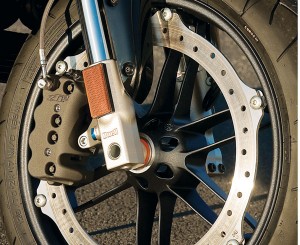
As for the rest of the motorcycle it’s all Buell. The new frame holds five gallons of fuel, although oil no longer resides in the swingarm since the Helicon engine is a dry-sump design and uses a more conventional tank location. A fully adjustable 47mm male-slider fork in front works in tandem with a fully adjustable shock that’s bolted directly to the swingarm without the use of a linkage. The latest generation of Buell’s signature Zero Torsional Load front brake system uses a 375mm front brake rotor, perimeter mounted on the wheel, and the same eight-piston caliper used on the XBRR production racebikes. In the rear the caliper is directly mounted to the swingarm and squeezes a 240mm rotor.
And then there’s that bulbous front end. While it’s surely not going to win any beauty contests, Buell insists that its wind tunnel research deemed this the best way to keep wind away from the rider. To call his bluff, we got to ride the 1125R on the roads surrounding Monterey, California, and on the famous Laguna Seca racetrack. There was only one caveat: the bikes we rode were preproduction models with suspension and fuel-injection settings yet to be finalized.
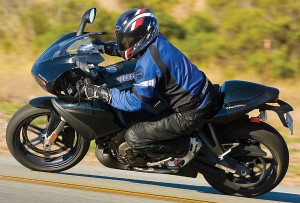
We started our ride on the street, where it didn’t take very long to realize that the ergonomics of the 1125 are actually somewhat comfortable–the clip-ons aren’t super low and the footpegs aren’t ridiculously high. The electronic fuel injection needed more calibration work under 3,000 rpm, but with such a flat torque curve there’s plenty of grunt to get you going once you’re past that mark, no matter what gear you’re in. Speaking of gears, it’s immediately apparent from the first click that the gearbox on the 1125R is light years ahead of its air-cooled siblings. Only slight flicks of the toe were all it took to choose a gear. Say what you will about the front cowling, it offers great wind protection…even while sitting up!
Being preproduction models, however, several shortcomings made themselves apparent rather quickly. Not more than 30 minutes into the ride I noticed my right foot getting warm. Being stuck in traffic didn’t help as the lack of airflow made the heat unbearable after an hour or so. At the lunch break about half of the journalists said they had noticed the heat, so I secretly swapped bikes hoping for an improvement. The trick worked…well, sort of–the heat was still present, but it wasn’t nearly as distracting.
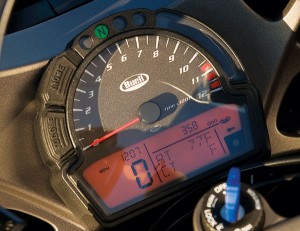
As we worked our way along a number of winding roads that line California’s central coast, the redeeming quality that Buells are known for shone through: The ability to carve a corner. Thankfully none of that magic is lost on the 1125R. The bike is quick to respond to bar inputs, and firm countersteering from the rider results in quick side-to-side transitions.
For the Laguna Seca track the bikes were fitted with either .95 or 1.0 springs, as the final rate hadn’t been determined yet. With the .95s the bike would soak up imperfections in the road and give more feedback through the bars, while the 1.0 springs bounced over bumps and felt vague when leaned over. The softer springs also helped the bike midturn, as it could track a more precise line without the tendency to run wide. In typical Buell style, knee-dragging lean angles were also easy to reach and were seemingly only limited by the rider’s courage.
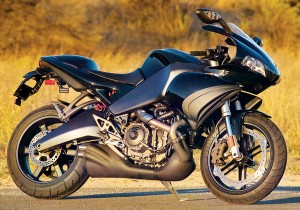
The flat torque curve that was a hit on the street was even more enjoyable on the track, as it makes the 1125 an easy bike to ride. Exiting Laguna’s slow second-gear last turn and whacking the throttle open, one can hear the huge 61mm throttle bodies sucking in air like a blue whale ingesting plankton. Once on the front straight and charging ahead one starts to appreciate how much time the design team spent in the wind tunnel. Call it what you will, the front fairing simply works when in a tuck. In those brief moments behind the windscreen time stood still. Charging up over the hill and into Turn Two, reality comes rushing back as you pop out of the tuck. Off the throttle the 1125 felt like it wasn’t engine braking–almost like a two stroke. Squeeze on the brake lever and initially nothing happens. Once it senses you’re thoroughly worried, the massive brake caliper finally bites down and slows you rapidly. The rear brake is Ducatilike in its wooden, seemingly ineffective feeling, which some riders prefer to one that requires extremely careful modulation in a corner.
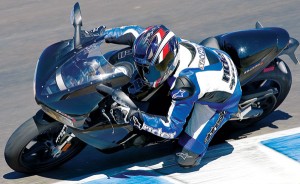
All in all the 2008 Buell 1125R is a huge step forward for the company. The groundwork for a good motorcycle is there, but one gets the feeling that the bikes we rode were rushed into the truck in time for this launch. By the time you’re reading this, production-ready models will be rolling out of Wisconsin and will retail for $11,995.







